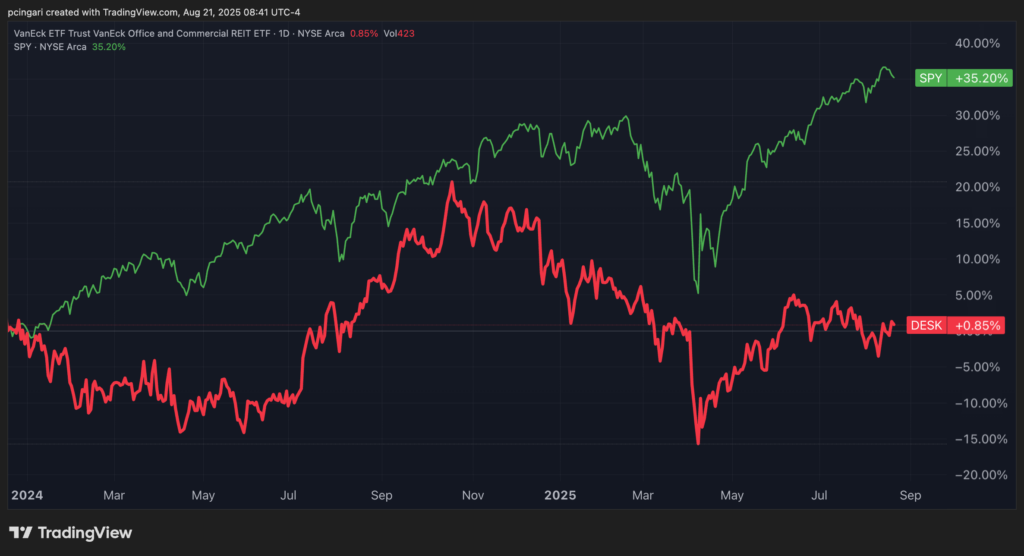New York's Office Boom Stands Alone As Most US Cities Stay Remote
New York's return-to-office numbers are surging and corporate giants are pouring billions into new towers, but the rest of America's office desks are still empty.
New York City has just reached a symbolic milestone. In July 2025, office visits in Manhattan rose 1.3% above the same month in 2019, according to data from location analytics firm Placer.ai.
It's the first time a major U.S. city has surpassed pre-pandemic office traffic. But far from disproving the work-from-home shift, the data actually shows how unusual New York has become.
Is New York The Exception, Not The Rule?
While The New York Post recently suggested that the office comeback narrative has been underreported, the numbers from Placer.ai tell a more nuanced — and more national — story.
Across the country, office foot traffic is still down 25.6% from pre-pandemic levels. Los Angeles is off by 40%, San Francisco by 34.6%, and Chicago by 34.2%. Even Washington, D.C., a historically government-driven town, lags by 30.9%. Only Miami came close to New York, with a difference of -0.1%.
As journalist Alec MacGillis wrote on X, it's "really striking to what degree NY has become an outlier in recovering from the remote-work shift, especially given that it is the city that was hit first and hardest by the pandemic that prompted the shift."
Why Is New York The Exception?
Wall Street is a major driver.
JPMorgan Chase & Co. (NYSE:JPM) and Goldman Sachs Inc. (NYSE:GS) have pulled thousands of workers back into their towers, with strict return-to-office mandates.
JPMorgan alone will soon open its 2.5-million-square-foot global headquarters at 270 Park Ave., a $3 billion glass-and-steel statement about the future of in-person work.
Luxury plays a big role, too. Companies have rushed to secure high-end space in Midtown and Hudson Yards. Deloitte pre-leased 800,000 square feet before construction even finished. In the first six months of 2025, Manhattan's Class A "trophy" buildings saw 2 million square feet of leasing activity.
Office Real Estate Stocks Tell The Truth
If the return to office was truly widespread, as some recent headlines suggest, then the stock market hasn't received the memo. The performance of the largest publicly traded office real estate investment trusts (REITs) tells a starkly different story—one of structural weakness, not recovery.
More than five years after COVID-19 upended workplace norms, major U.S. office REITs remain deeply underwater, down between 35% and 67% compared to their mid-February 2020 levels.
Shares of Cousins Properties (NYSE:CUZ) are still down 35% from pre-Covid levels. Vornado Realty Trust (NYSE:VNO) and SL Green Realty Corp. (NYSE:SLG) are each down around 46%, while Boston Properties (NYSE:BXP) has lost 55%.
The worst performers include Kilroy Realty Corp. (NYSE:KRC) and Douglas Emmett Inc. (NYSE:DEI), both down more than 55% and 67%, respectively.
Performance Of Office REITs Stocks (Aug. 20, 2025 vs. Feb. 18, 2020)

This isn't just a temporary lag—it's a sign of deeper, structural shifts in the way people work and how companies use space. Investors are betting that hybrid work, downsizing, and selective leasing will continue to weigh on the sector.
The market's broader skepticism toward office stocks is also evident in the VanEck Office and Commercial REIT ETF (NYSE:DESK). Launched in September 2023 as a focused play on office recovery, the fund is trading mostly flat since December 2023—during the same period, the S&P 500 has rallied 35%.
In other words, Wall Street isn't buying the return-to-office hype.

Read Next:
Photo: phototrip2403/Shutterstock
Contact Us
Contact Number : +852 3852 8500Service Email : service@webull.hkBusiness Cooperation : marketinghk@webull.hkWebull Securities Limited is licensed with the Securities and Futures Commission of Hong Kong (CE No. BNG700) for carrying out Type 1 License for Dealing in Securities, Type 2 License for Dealing in Futures Contracts and Type 4 License for Advising on Securities.

English